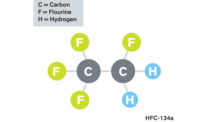
Here is an example of a potential relay rating specification. The continuous coil voltage is 300; pick-up voltage is 285 minimum and 305 maximum; and the dropout voltage is 77 maximum. The pick-up voltage for a specific potential relay will be listed as a minimum and a maximum. The actual pick-up voltage must stay within its range for proper operation. The pick-up is the back electro-magnetic field (EMF) voltage generated across the start winding by the motor's rotor when it is up to about ¼ speed.
If the pick-up voltage generated by back EMF is under the minimum, the contacts between terminals one and two will never open. The start capacitor will then stay in the circuit. This will cause high amp draws and open motor protective devices.
If the pick-up voltage generated by back EMF is above the maximum, the relay coil stands a good chance to overheat and open circuit. Again, the contacts between one and two would stay closed, causing high amp draws if the relay coil opens circuit.
Potential relays also have a continuous voltage rating. This is the maximum back EMF that the relay's coil can tolerate continuously without overheating and opening circuit.

DROP-OUT VOLTAGE
Potential relays also have a drop-out voltage rating. The drop-out voltage is the back EMF voltage that must be generated across the relay coil to hold the contacts open once they have been picked up (opened). Note that it takes more back EMF (pick-up voltage) to pick up and open the contacts than it does to hold (drop-out voltage) them open. Once the cycling control opens the circuit, the rotor will decrease in speed, and then will generate less back EMF across the start winding and relay coil. As the back EMF drops below the drop-out voltage, the contacts between one and two will return to their normally closed position and be ready for the next starting cycle.Because of these three voltage rating specifications, service technicians must be sure that potential relays are sized to each individual compressor. Consult the service manual, a compressor manufacturer, or a supply house for information on selecting the correct potential relay. Replacement relays can be cross-referenced for different manufacturers using convenient tables. Whenever possible, the model number on the new relay should be used when ordering a new relay.
There is a patent pending for a potential relay with an adjustable pick-up voltage range. This relay is currently on the market and has the ability to replace all relays presently manufactured.
TROUBLESHOOTING
A simple ohmmeter is all that is needed to troubleshoot a potential relay. After taking all connecting wires off the relay, measure the resistance across terminals one and two (Fig. 1). The resistance should read close to zero, since they are normally closed contacts. If the reader reads infinity, the contacts are stuck open, and the relay should be discarded and replaced.Open contacts will prevent the start capacitor and start winding circuit from being energized. This will lock the rotor and cause locked rotor amps, thus opening the compressor's protection device. Short cycling on the compressor's compression device can overheat and open a winding in time.
Often the relay contacts could be stuck or arced in the closed position. In this case, the start capacitor would never be taken out of the circuit, and high amp draw would open motor protective devices. If the contacts are stuck in the closed position, the relay will have to be checked in the running mode, since the contacts between one and two are normally closed when not in operation.
Once the motor is up and running, use a voltmeter to measure the voltage across terminals one and two. A voltage reading of 0 volts would prove that the contacts are not opening.
Also, high amp draws from the start capacitor, and the start capacitor and the start winding circuit still being energized is a tell-tale sign that the contacts have not opened.
COIL
After disconnecting all wires from the relay, ohm the coil between terminals two and five on the relay. Since this coil should have very high resistance, make sure you are using the proper scale on the ohmmeter. The R X 100 scale is a good one to use. (The R X 1 scale can fool a technician into believing that there is an open coil because of the coil's extremely high resistance. It is not uncommon to have the resistance read in the many thousands of ohms.)If the ohmmeter reads infinity on the R X 100 scale, the relay coil is opened. The relay should be discarded, and a new one installed. An open relay coil will prevent the contacts between one and two from opening. This is caused from no magnetism in the iron core. This will cause high amp draws. Always use the old model numbers on the old relay when ordering a new one, or cross-reference it with a different manufacturer's relay.
Publication date: 08/07/2006



